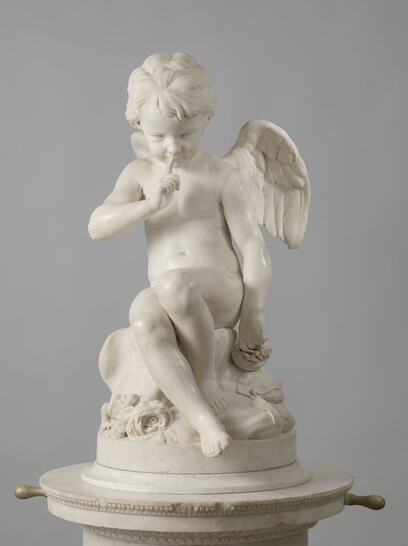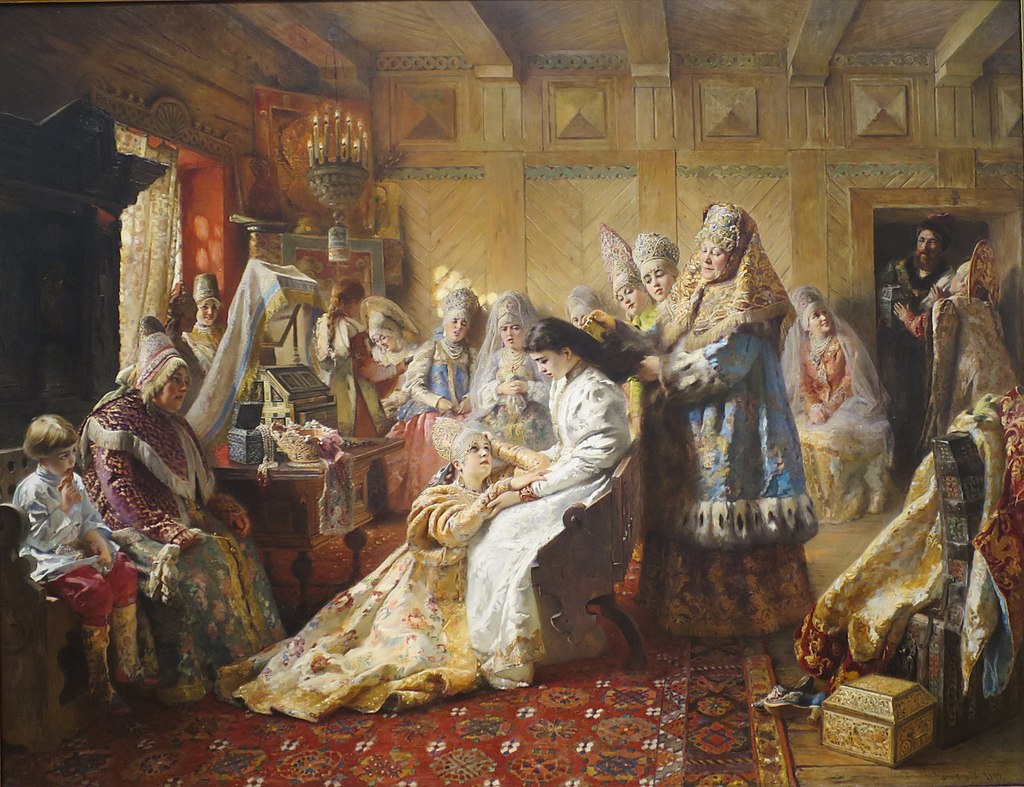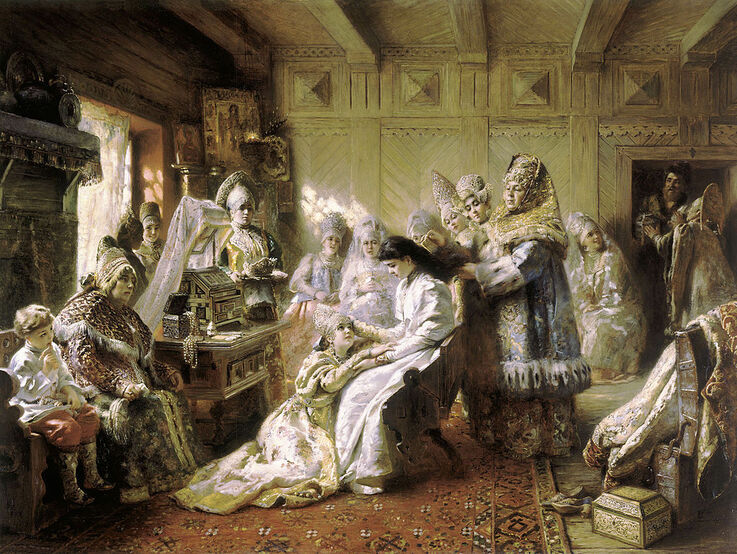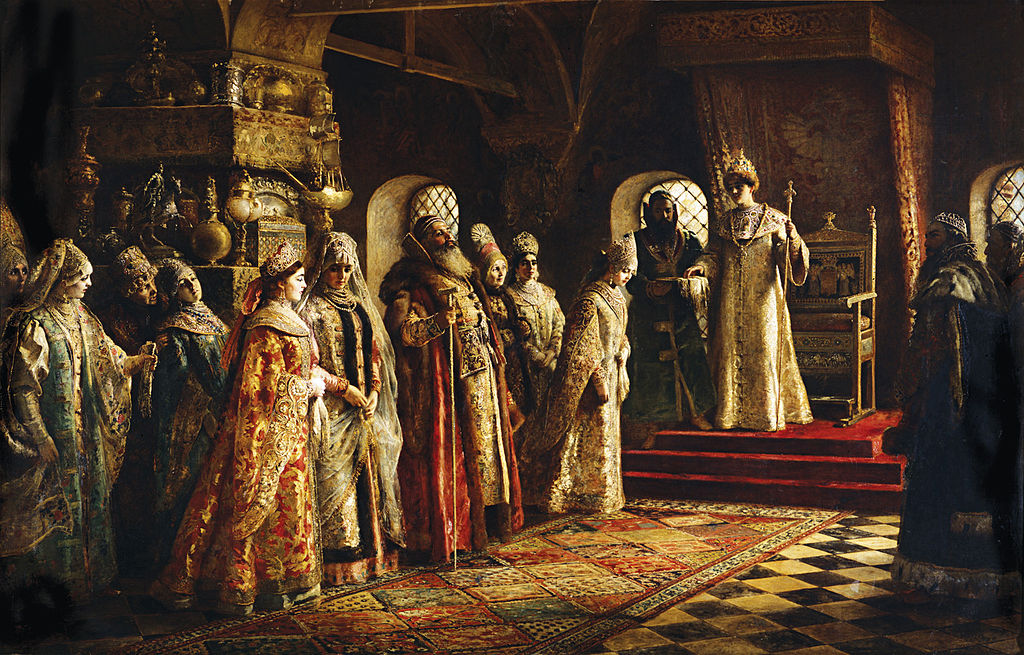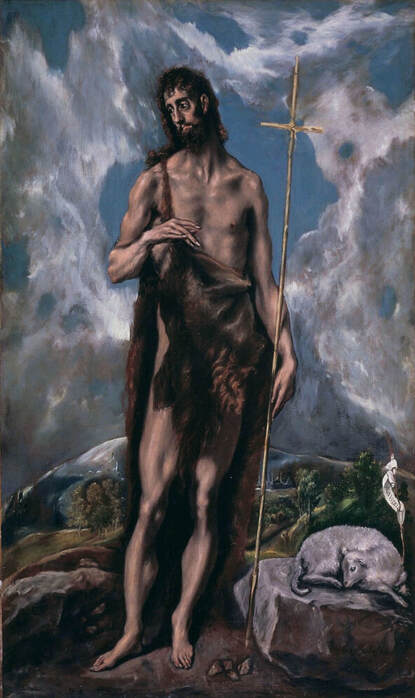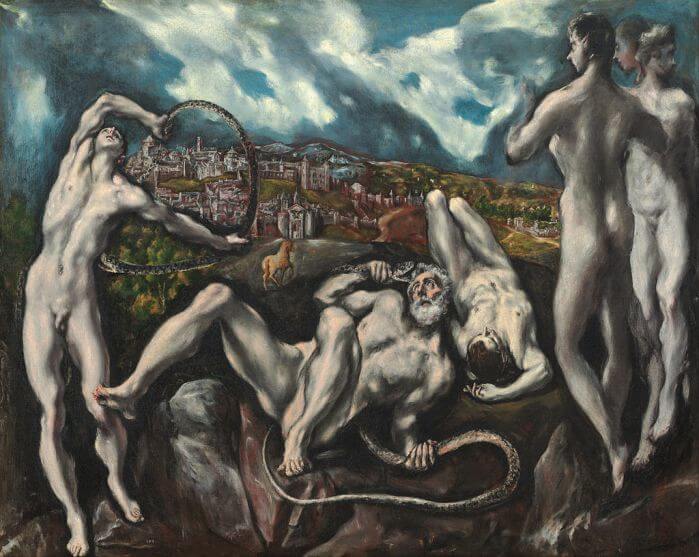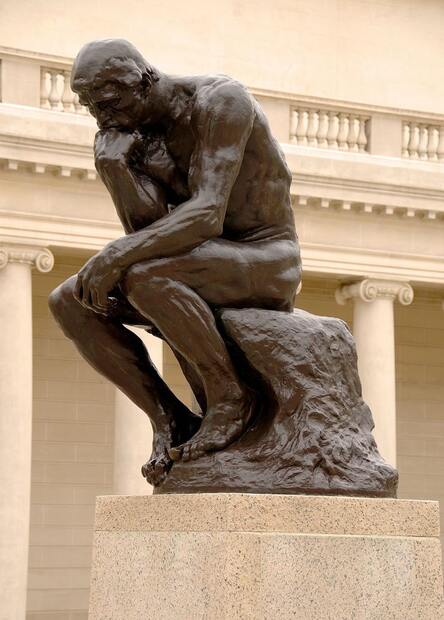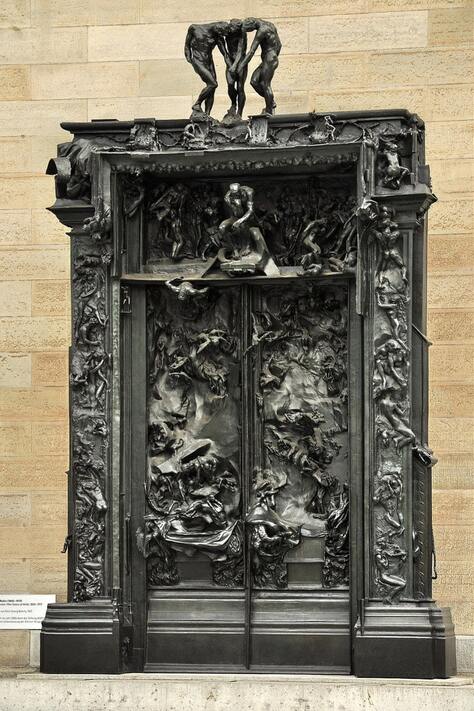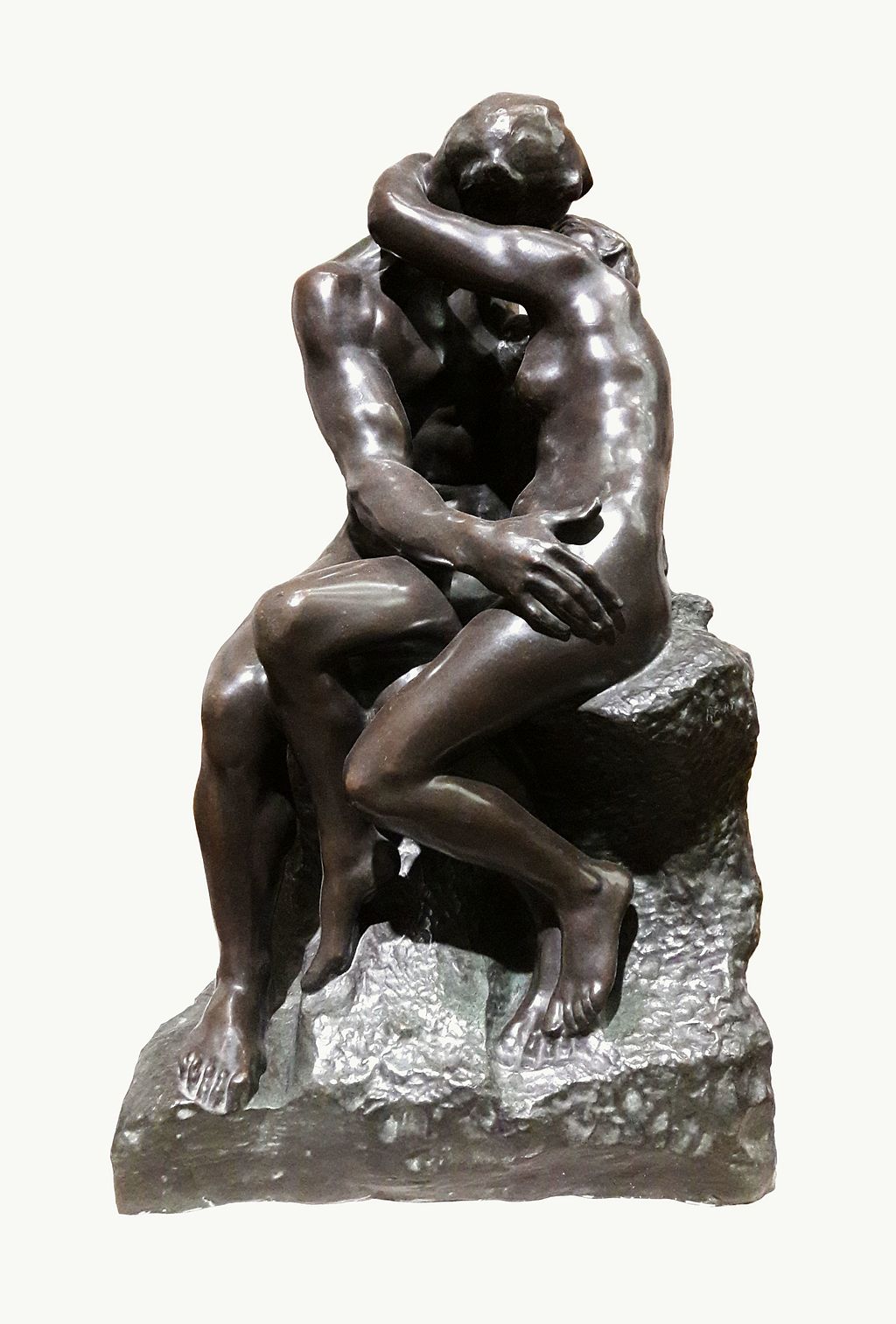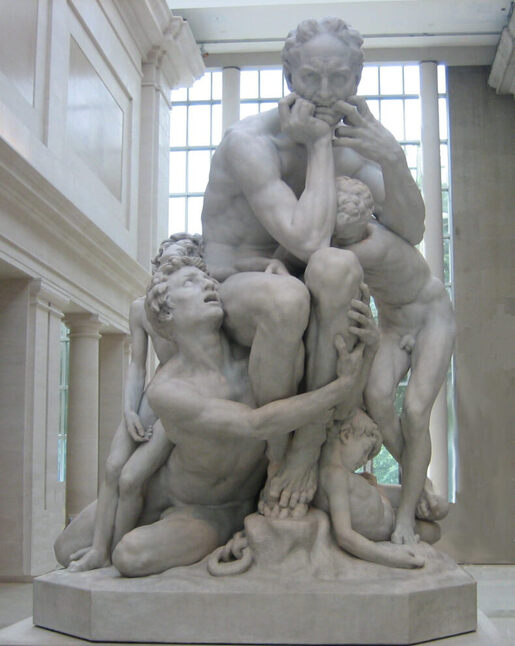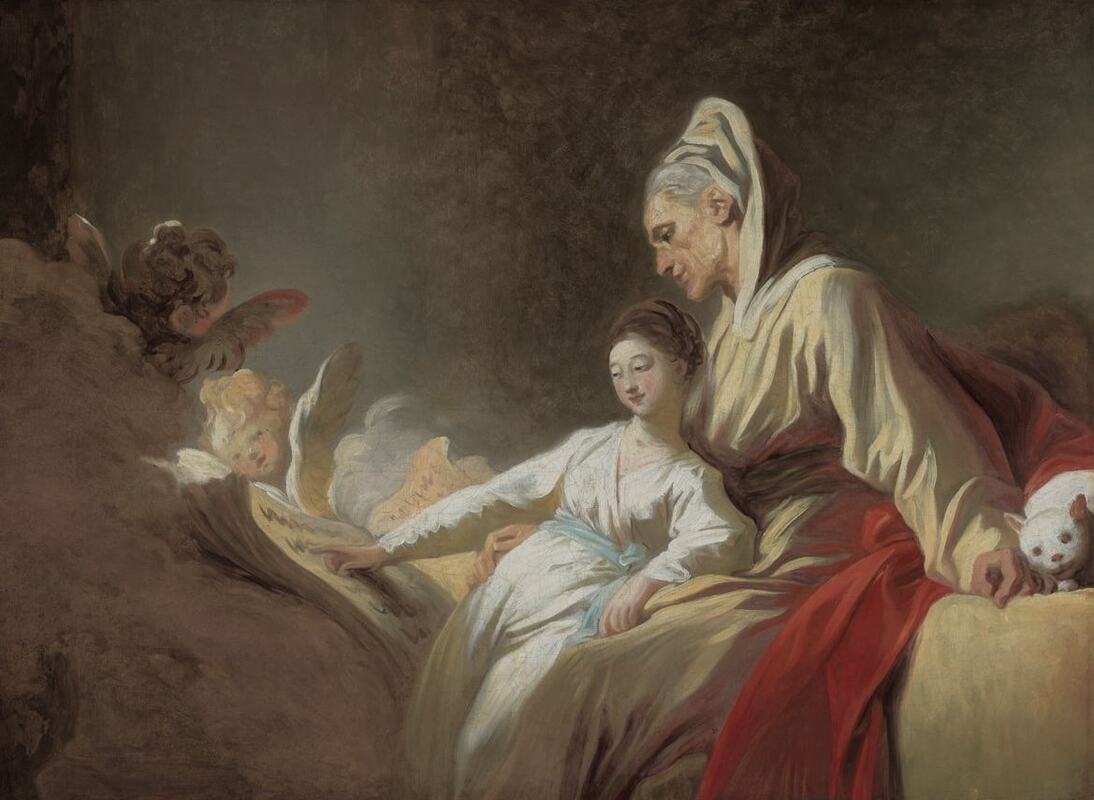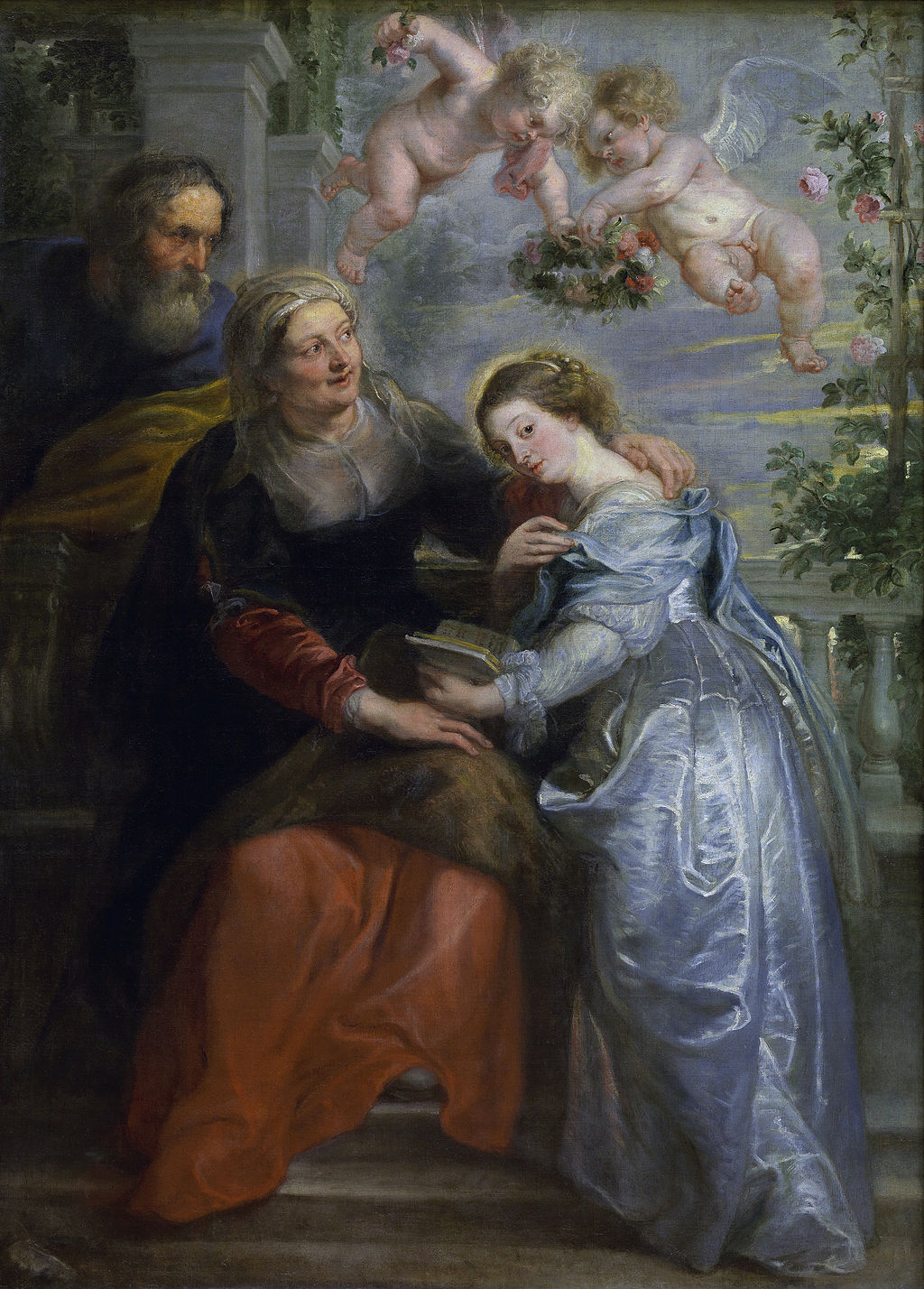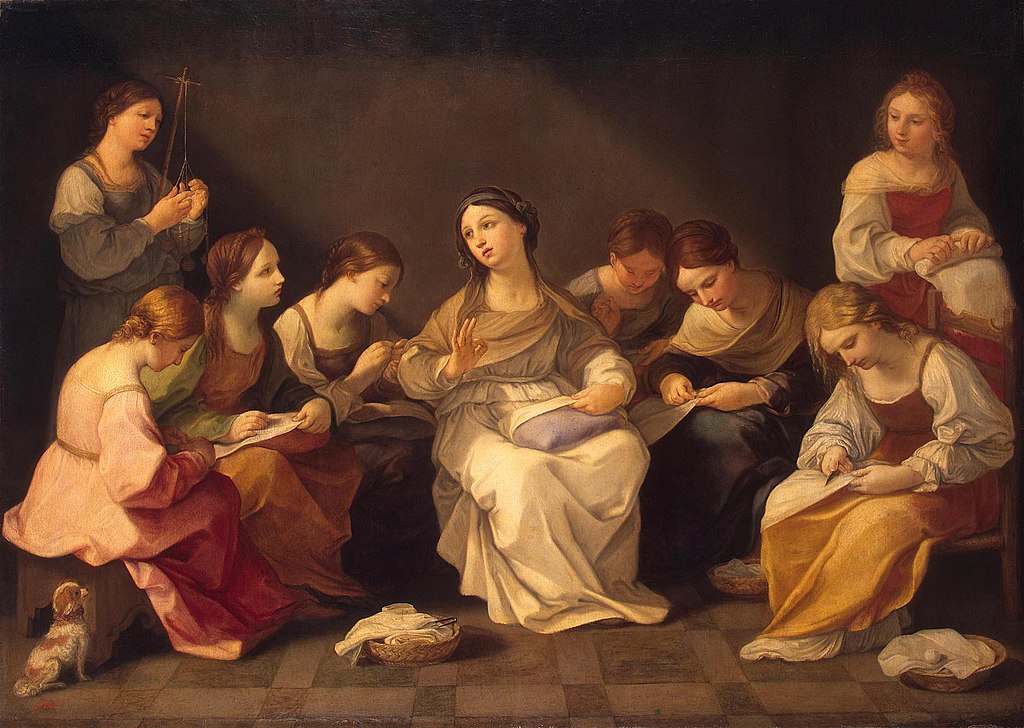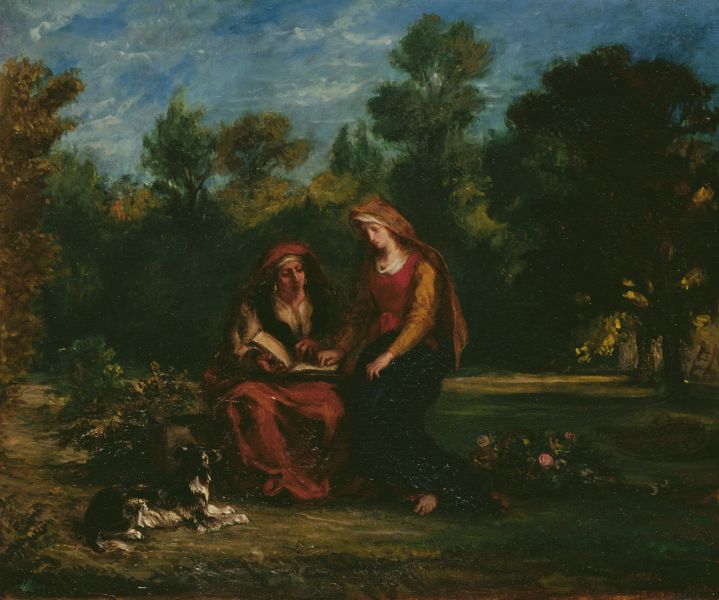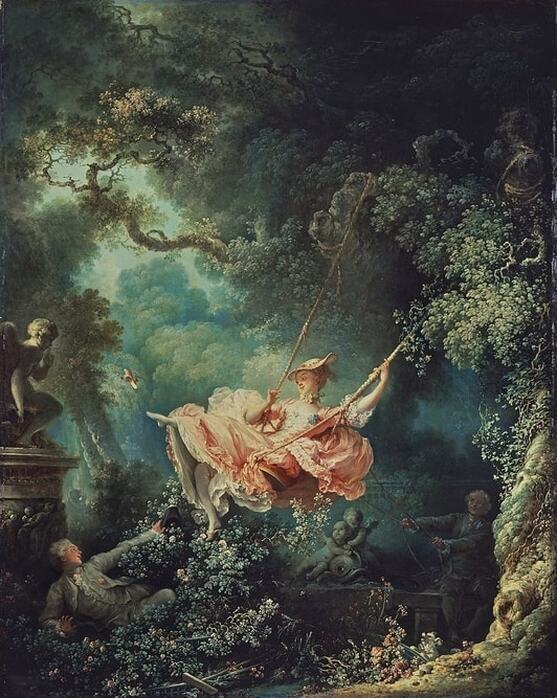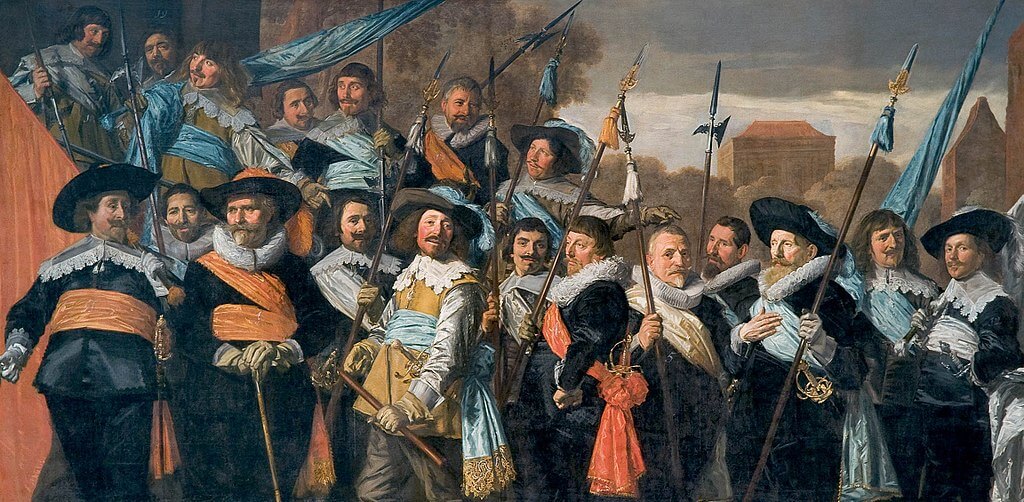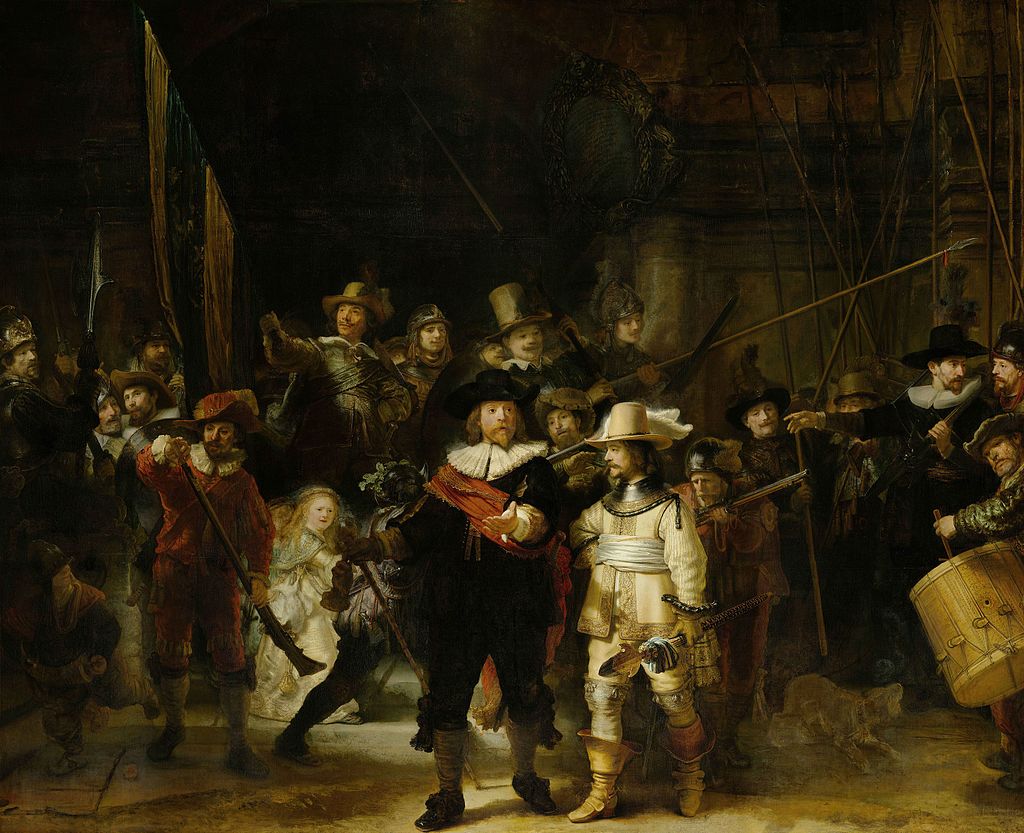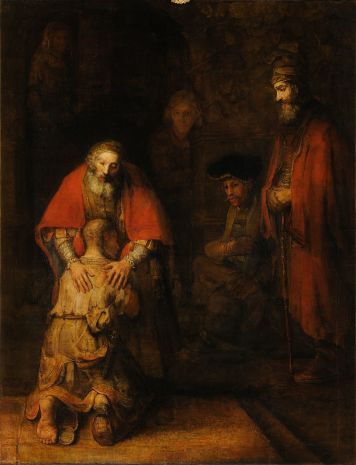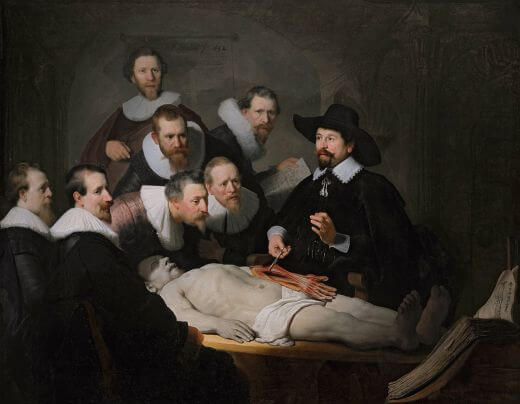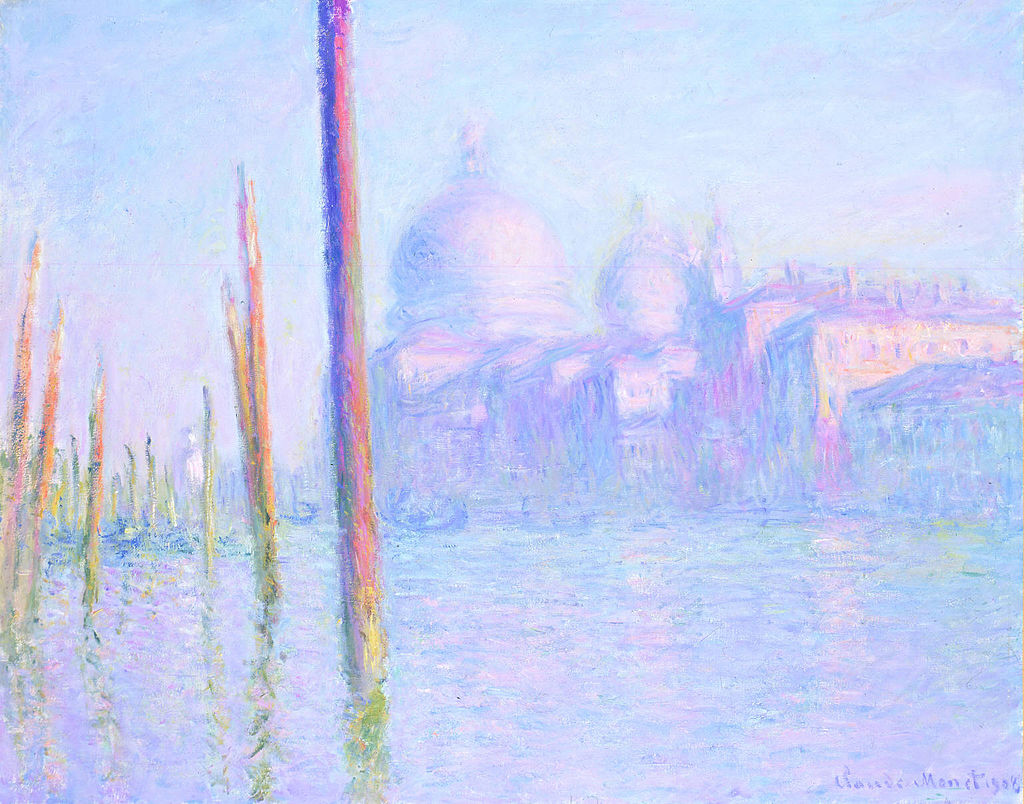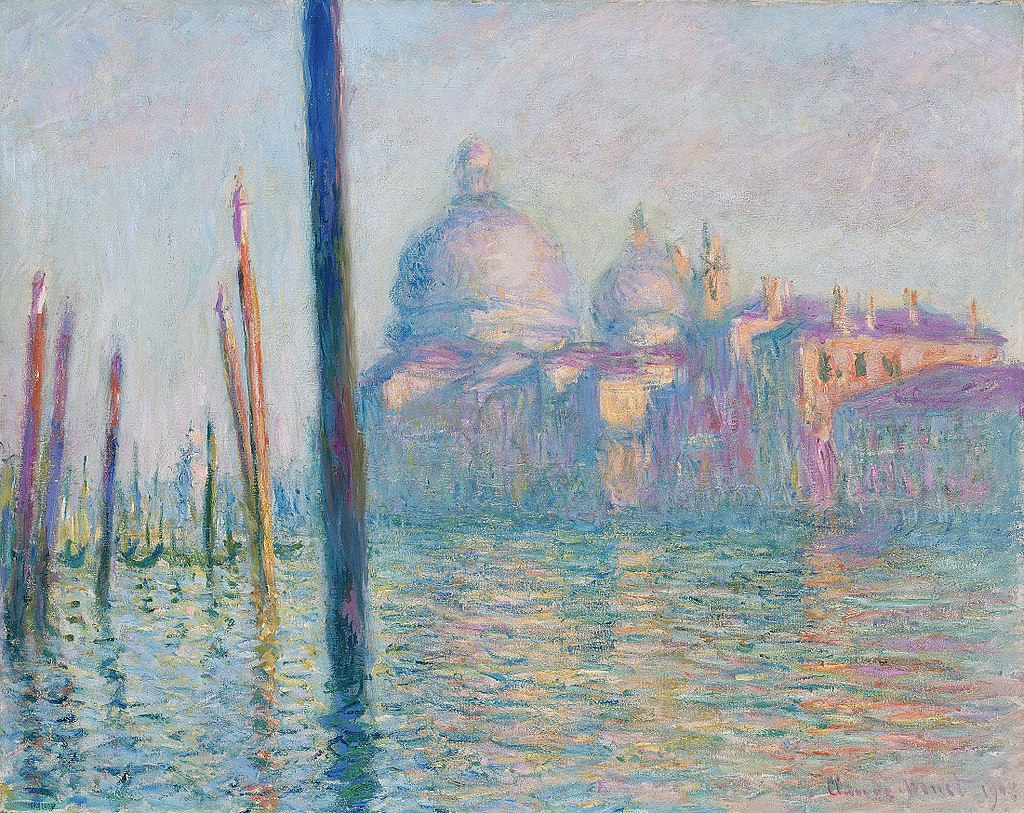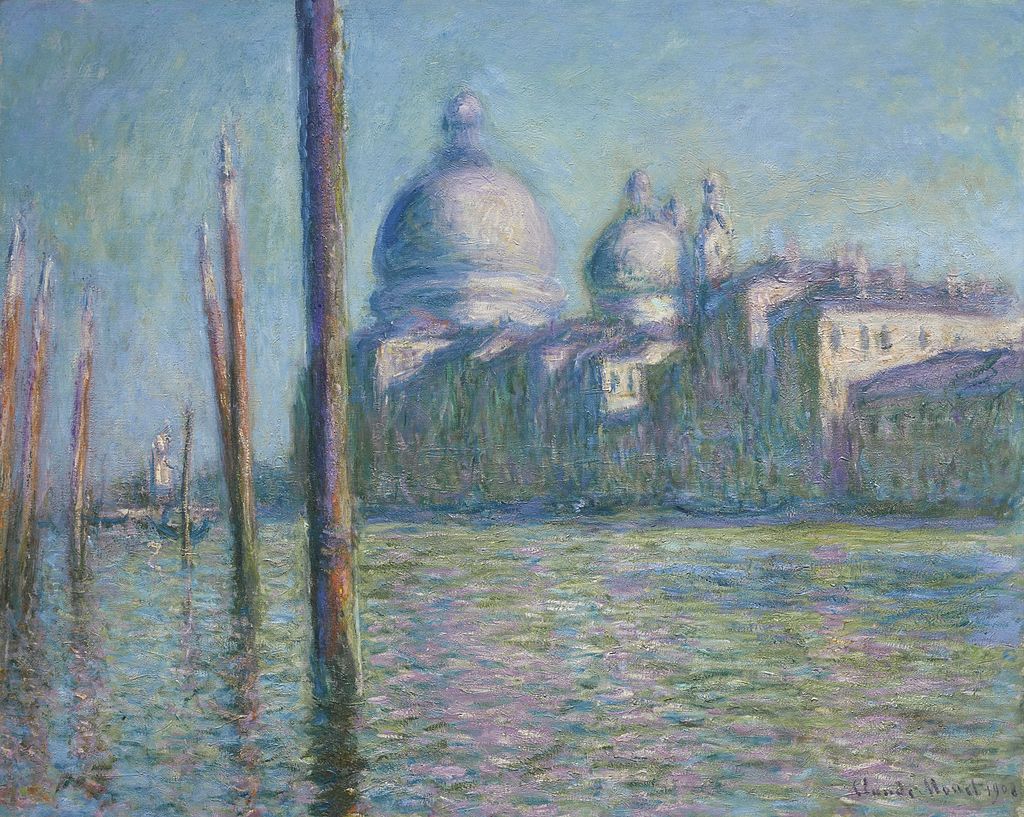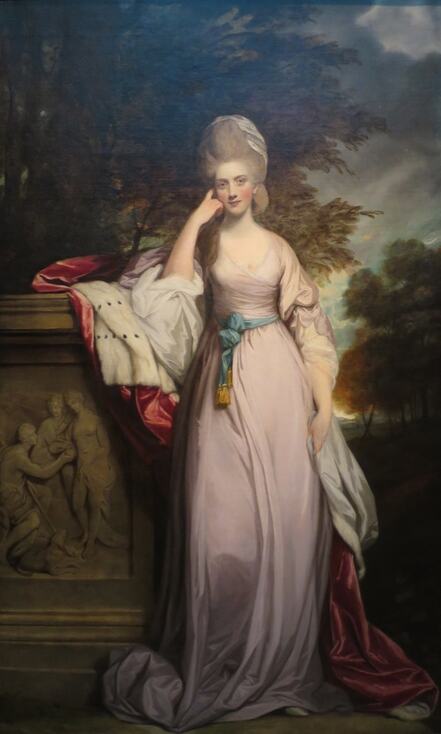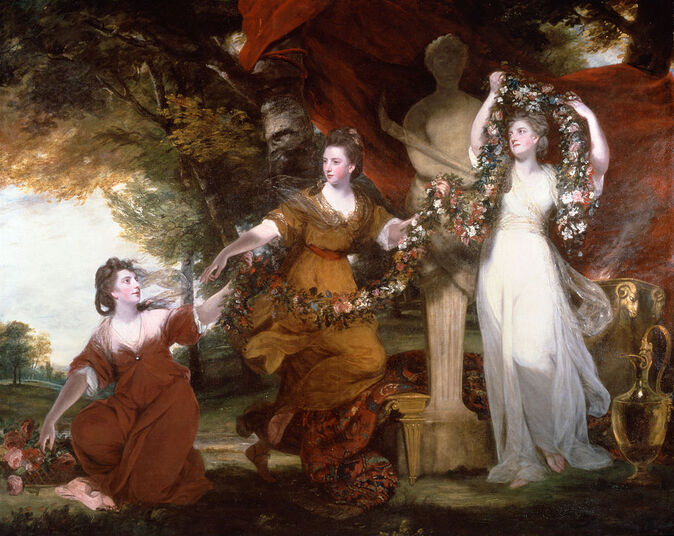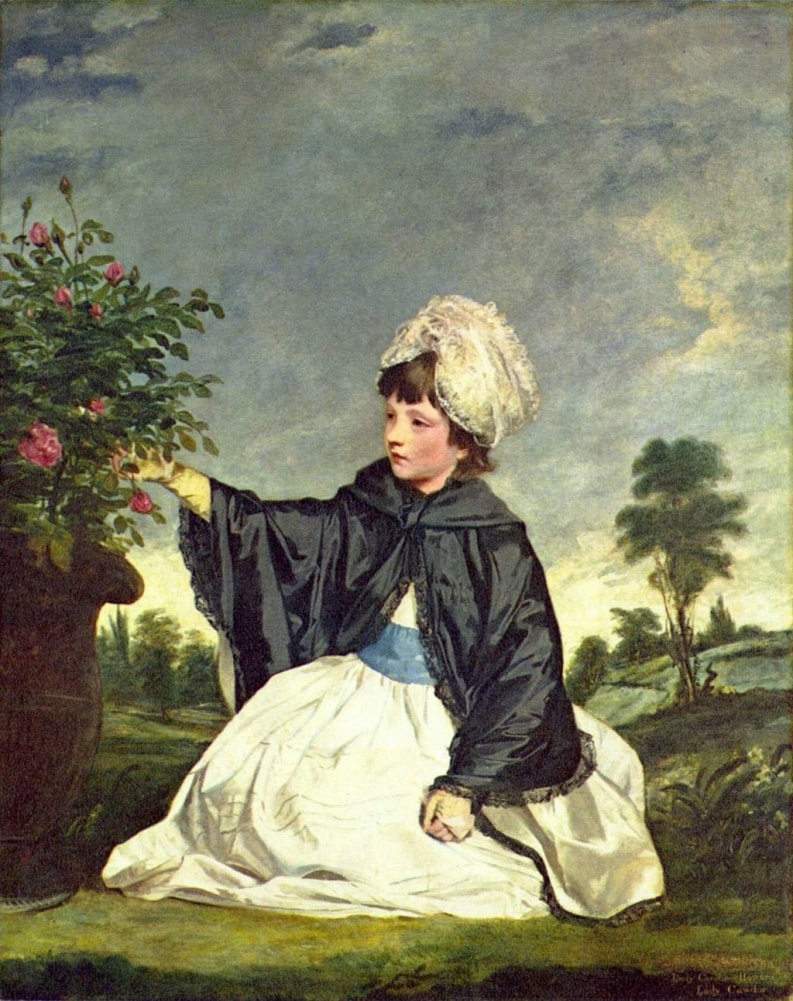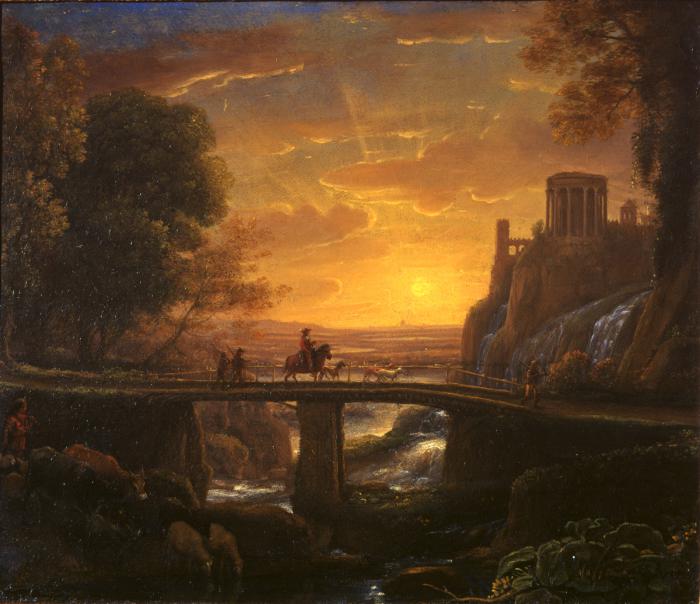|
Where? The Oval Drawing Room of the Wallace Collection
When? 1767-1768 What do you see? Golden light pours through the trees of a garden. A young woman in a brilliant pink dress sits on a large swing that is attached to the trees behind her. She kicks off one of her pink shoes (look above her raised foot) in the direction of the statue of a cupid on the left. As her skirt flares upwards, her young lover in the lower left is taken aback by the sight before him. He has his hat in his left hand. Unaware of the scene in front of him, an older man smiles as he operates the swing in the lower right. Near his feet is a little white dog that perhaps symbolizes an ironic fidelity. The sculpture of the cupid on the left was created by Étienne-Maurice Falconet in 1757 and versions of this statue are in the British Museum, Louvre, and the Rijksmuseum. It is popularly known as Menacing Love, and shows cupid looking down on the scene while putting a finger to his lips saying: “this is a secret.”
Backstory: This painting is also known under the more complete title “The Happy Accidents of the Swing.” This title refers to the erotic references in this painting. The man that is hiding in the bushes on the left has a chance to look at the woman’s legs under her skirt. The slipper that the woman kicks in the air and the hat of the man are a reference to their sexual availability. The statues of the cupids confirm the sexual intentions of the couple even more.
Fragonard’s painting soon gained recognition, and he became popular with a small group of patrons with a taste for erotic works as well as history painting. As such, The Swing played an important role in boosting Fragonard’s artistic career. Who is Fragonard? Born in 1732, Jean-Honoré Fragonard was a French Rococo painter. As a boy, he had a passion for drawing and eventually became the student of François Boucher. In 1752, Boucher suggested Fragonard to apply to study under Carle Van Loo, the court painter to Louis XV. This involved studying at the French Academy in Rome. While there, Fragonard made many sketches of the countryside and copied many Baroque-style paintings by Hubert Robert. His good work in the Academy was admired by many, and even Louis XV purchased one of his artworks. Fragonard soon gained more recognition and earned a studio in the Louvre Palace as well as the title of an Academician. Over time, Fragonard painted in many styles: Baroque, Romantic, and Rococo. In addition, he painted a variety of paintings, including landscapes, portraits, party scenes, and religious paintings. As his frivolous Rococo paintings were not also easy to sell, he also created some more traditional works on commission, such as the Education of the Virgin in the Legion of Honor Museum.
What is Rococo? An art style popular between 1720 and 1780 in Europe. The style is relatively chaotic and theatrics, leading to artworks that are full of drama, emotion, and movement. The style is highly feminized and popularly used in the French salons run by women in the 18th century. Some of the most successful artists following this style include François Boucher, Jean-Honoré Fragonard, and Antoine Watteau.
Fun Fact: Fragonard was not the artist originally commissioned to paint the swing. At first, Gabriel-François Doyen was given the task by an anonymous man of the court. He had requested a painting of his mistress being pushed on a swing by a bishop as he admired her from below. However, Doyen turned him down. Instead, Fragonard took up the task. Fragonard did not follow all the instructions of the commissioner and kept his own artistic freedom. For example, he decided against painting the man pushing the swing as a bishop. And he included some extra details to the painting such as the little dog, statues of cupids, and the lost slipper.
0 Comments
Where? Gallery 17 of the Legion of Honor Museum
When? 1889 What do you see? A life-size depiction of a scene before a 17th-century Russian wedding. The girl dressed in white in the center is about to get married to the tsar. She looks pale, and her sister is at her feet. The bride did not choose her partner, and she is not looking forward to the wedding and the rest of her life. She will have to give up her happy life as a teenager and faces a life in which she will have to do whatever the tsar demands. Most of her female friends and family members surrounding her share the somber mood. The mood is in stark contrast with the sumptuous, colorful outfits of the wedding guests. Tradition prescribes that only women can be present while the bride is prepared for the wedding. An exception is made for the little boy sitting on the left. However, the man entering the room – possibly the bride’s father - is not welcome and is urged to leave the room. Backstory: The bride’s name is Maria Ilyinichna Miloslavskaya. She is about to get married to the 18-year old Tsar Alexis I. Makovsky created two versions of this painting. The first version is on display in Serpukhov`s Museum of History and Art. This version is much less colorful and almost eight times smaller than the version in the Legion of Honor. Makovsky used his second wife as the model for the bride in this painting. When this painting was traveling through the United States in 1893, Michael Henry de Young bought the painting. He left the painting for the museum that was eventually named after him, the De Young Museum, which forms together with the Legion of Honor Museum the Fine Arts Museums of San Francisco.
Bridal theme: Makovsky enjoyed painting the 17th-century life of the Russian upper class. He created several portraits and large paintings on this topic. Among his paintings is also The Choice of the Bride in the Museo de Arte de Ponce in Puerto Rico. In this painting, potential brides for the tsar line up and the tsar can choose who he wants to marry. The young women have no say in this as the tsar’s word is law.
Who is Makovsky? Konstantin Yegorovich Makovsky was born in 1836 in Moscow. The artistic gene ran in the family as his father and brothers were artists as well. He was one of the most successful Russian painters of his generation and loved to spend his earnings on traveling across the world. He died in 1915 in Saint Petersburg.
His works are a combination of the Realist and Academic art styles. He painted a variety of themes, including historical and mythological topics, genre pieces, and portraits. His most famous mythological work is probably The Judgment of Paris in the Faberge Museum in Saint Petersburg. A nice example of Makovsky’s portraits is the Portrait of Varvara Bibikova in the Hermitage Museum in Saint Petersburg.
Fun fact: The size and colors make this painting look very impressive. One is inclined to think at first glance that Makovsky painted a happy occasion. But a better look at the bride tells a different story. This story is emphasized by the faces of the other guests in the room. They do not look happy either. However, Makovsky did not make an effort to express much emotion on these faces. They mostly look dull and expressionless.
While Makovsky was an accomplished portrait painter, he clearly did not make a big effort in painting meaningful faces and expressions. Instead, he focused on the coloring, which was his main interest during this stage of his career. Interested in a copy for yourself? Poster
Where? Gallery 5 of the Legion of Honor Museum
When? Around 1600 Commissioned by? The Convent of the Discalced Carmelites in Malagón, Spain. What do you see? The elongated figure of Saint John the Baptist. He looks unusually tall and thin, typical of the style of El Greco. Saint John the Baptist wears a robe of camel skin, and a long cross stands to his side. On the right, a lamb lies down on a rock. Next to the rock is a stick with a banner reading “AGNUS DEI” (Lamb of God), which is how Saint John the Baptist refers to Jesus in John 1. The Lamb of God refers to Jesus’ role in taking away the sins of the world through his crucifixion (to which the cross explicitly refers). El Greco uses a low horizon and dedicates more than half of the painting to a luminous sky. The bright light from the sky reflects on the hills in the background. El Greco places Saint John the Baptist in the middle of a landscape. The building next to his left knee is the Monasterio del Escorial, a historical residence of the King of Spain located 30 miles outside of Madrid. Backstory: El Greco painted this work while living in Toledo, Spain. The Legion of Honor Museum acquired this painting in 1946. It is displayed next to two other paintings by El Greco in the museum. Other versions: El Greco painted several variations on this painting. A very similar version of Saint John the Baptist is in the Museu de Belles Arts de València. The main difference between both versions is that El Greco worked out some more details in the background of the Legion of Honor version, and he changed the placement of the lamb next to Saint John the Baptist. Another similar version of Saint John the Baptist is owned by the Prado Museum and on display in Toledo. This version shows Saint John the Baptist together with Saint John the Evangelist. For this painting, El Greco used the help of his workshop.
Who is Saint John the Baptist? A preacher who foretold the coming of Jesus. During his life, he baptized many people to wash away their sins. His most important deed was the baptism of Jesus. He is the patron saint of Jordan and Puerto Rico, as well as cities like Florence and Porto.
Who is El Greco? Doménikos Theotokópoulos was born in 1541 in Heraklion, Greece, and died in 1614 in Toledo, Spain. He is better known as El Greco (the Greek). During his twenties and thirties, he spent several years in Italian cities like Venice and Rome, where he got inspiration from artists like Michelangelo, Tintoretto, and Titian. He eventually moved to Toledo, near Madrid. El Greco developed a unique style that is difficult to classify as it was so different from all other painters. He was a Mannerist, he was very expressive, and his works contain some fantasy-like elements. His work has inspired many artists over time, including Delacroix, Manet, and Picasso. He painted both religious and mythological works. An example of the latter is his Laocoön in the National Gallery of Art.
Fun fact: The extremely elongated figures are a recurring theme in the works of El Greco. It is not certain why El Greco used this style, but there are two main explanations.
Where?
When? Rodin created the original sculpture in 1881. He created the first monumental-size sculpture in 1903 and after this many casts of the sculpture have been created, even after his death in 1917. What do you see? A sculpture of a muscular, naked man sitting on a rock. The man is in deep thought and uses his whole body to think. His head is bent forward and leans on his right hand. His wrinkled face, knitted eyebrows, swollen nostrils, compressed lips, and absent-minded gaze reinforce the idea that the man is deep in his thoughts and is completely unaware of the world around him. The man is struggling with his thoughts with every part of his body. Almost no part of his body is relaxed. Most muscles are tense, which is clear by looking at the clenched fist, the arched back, the legs below his body, and the squeezed toes. The statue is over six feet tall making the figure larger than life. It was the intention of Rodin to put the independent sculpture on top of a pedestal such that it would make a colossal impression on the viewers. Backstory: In 1880, Rodin received a large commission from the Directorate of Fine Arts in France to create the entrance doors for a new museum that was to be built (but never opened in the end). He was given the freedom to choose his own theme and decided on creating a scene from Dante’s book Inferno. Rodin was supposed to finish the project in five years but continued to work on the project for 37 years until his death in 1917. The doors – named The Gates of Hell – would eventually include a total of 180 different figures, and they would form the basis for many of Rodin’s most famous statues. Rodin originally created all figures in plaster, and the doors were then to be cast in bronze. The central and the most important part Rodin created for these doors was the statue of The Thinker (Le Penseur in French) who sits right above the two doors with all the characters from the Inferno behind him. The statue was about 27 inches (70 cm) high.
Multiple versions: The statue of The Thinker can be found all around the world. Rodin created the first version of this statue in plaster in 1881. In 1903, he completed the first monumental-size version of this statue. He considered it to be a remarkable piece and wrote to the client of his first bronze casting that he would ensure that only a few copies of the statue would ever be made. However, he did not keep his word.
During Rodin’s life, already more than 20 versions of The Thinker were produced. And after his death, the right for reproduction was turned over to the Republic of France. Nowadays, more than 70 bronze and plaster versions exist and are on display in Asia, Australia, Europe, North America, and South America. Interpretation: There are various interpretations of what and who The Thinker represents. When initially creating this statue as part of The Gates of Hell, Rodin meant the figure to represent Dante pondering about the fate of the damned people entering through the Gates of Hell. This interpretation is based on Dante’s book Inferno, the first part of his trilogy known as The Divine Comedy. When Rodin started to create independent versions, he started to consider different interpretations. Overall, he considered the statue to represent the struggle of the human mind. But he also started to see hope in it. The thoughts slowly become clear, and the man turns from a thinker, into a dreamer, and finally into a creator. Over time, other interpretations have also been given. Some consider the statue to represent Rodin himself. Others interpret the figure as Adam contemplating the sin he committed in Paradise. Who is Rodin? François Auguste René Rodin was born in 1840 in Paris, where he died 77 years later in 1917. He was rejected three times by the leading art school in Paris, the École des Beaux-Arts. It forced him to educate himself differently and this has contributed to his unique style. He was inspired by some of the great Renaissance sculptors like Donatello and Michelangelo. Most of Rodin's famous sculptures were originally intended for his commission of The Gates of Hell. Over time, he realized that he could turn many elements of The Gates of Hell into separate statues and some of these statues have achieved world fame. Among them are The Three Shades and The Kiss. Many of Rodin’s statues have been cast multiple times in bronze which means that his statues have spread across the world.
Why a bronze statue? Bronze is a combination of different metals. It consists primarily of copper (typically 85-90%) and tin (typically 10-15%), but can also contain minor quantities of other metals or nonmetals. It is an attractive material for sculptors for the following reasons.
Fun fact: While The Thinker is one of the most famous statues in the world, Rodin initially named this statue “the poet.” Later it was renamed based on suggestions by foundry workers that the sculpture was quite similar to a sculpture by Michelangelo on Lorenzo de’ Medici, Duke of Urbino. This sculpture was more popularly known as “Il Penseroso” (The Thinker), and this name was also given to Rodin’s statue. The Thinker also shows some resemblance to Ugolino and His Sons which was created by Jean-Baptiste Carpeaux in the 1860s.
Where? Gallery 7 of the Legion of Honor Museum
When? About 1773 What do you see? A young Mary comfortably leans back against her mother, Saint Anne, who teaches the Virgin Mary about the Bible. Mary has her finger on the Bible questioning her mother about a certain aspect. However, Mary seems confident as well and enjoys this activity with her mother. Fragonard included strong contrasts between mother and daughter. Mary is tiny and has a pale, doll-like face. Her oversized mother looks like a wise and experienced woman. On the left, they are accompanied by two small angels hovering next to the Bible to give them divine inspiration. On the right, they are joined by a white cat. Fragonard paints a mysterious light source in the background giving this painting a magical feel. The bottom left of the painting probably has been damaged over time, but, interestingly, the vaguely applied pink and brown paints add to the magical feeling of this work. Background: Fragonard got the inspiration for this painting from earlier works on this theme by Peter Paul Rubens and Giovanni Battista Tiepolo. Rubens painted the theme between 1630 and 1635 and this work is on display in The Royal Museums of Fine Arts in Antwerp. Between 1730 and 1732, Tiepolo painted the theme multiple times, including a version in the Santa Maria della Fava Church in Venice. Fragonard first copied the works of these artists but then created his own, unique composition of this theme. However, when he finished the work, it was not received well by the art critics of that time. It inspired him to create some other versions of this work.
The youth of Mary: The youth of the Virgin Mary is described in the apocryphal Gospel of James. Mary is the daughter of Saints Anne and Joachim. They were wealthy people, but Anne was infertile. After a desperate prayer to God, an angel appeared to her promising a child that would become famous. Anne became pregnant without intercourse with her husband.
When Mary was three years old, her parents brought her to the Temple where she would be raised by the priests and received food from the hand of an angel. When she was 12 years old, God picked Joseph, a widower with older children, to be Mary’s guardian and to become her husband when she was old enough. And when Mary was 16 years old, she became pregnant without having intercourse. Joseph actually only discovered her pregnancy when he came back from a house-building trip when she was already six months pregnant. The Education of the Virgin: The story of Saint Anne teaching her daughter Mary about the Bible only developed in the 11th century AD. It is not mentioned in the Gospel of James, which is the main source of information about Mary’s youth. In contrast, the Gospel of James mentions that Mary lived with the priests at the Temple between her third and twelfth year. The only skill of Mary mentioned in the gospel is that she was good at weaving. But 11th-century logic told priests and scholars that, as the Mother of Jesus, Mary also had to be able to read and be knowledgeable about the Bible. And so, artists in the next centuries started to depict Saint Anne teaching Mary about the Bible. Multiple versions: Fragonard created multiple versions of The Education of the Virgin. The version in the Legion of Honor Museum was probably the first version and painted around 1773. After that, he made two drawings of the painting for which he used the same composition but experimented with different lighting effects. During the second half of the 1770s, Fragonard created a second series on this topic. In these later paintings, Mary is no longer looking at the Bible but at her mother instead. The education of the virgin was a theme that multiple artists have used over time. Besides Rubens and Tiepolo, Guido Reni painted between 1640 and 1642 a version in the Hermitage Museum. And between 1842 and 1852, Eugene Delacroix also painted a couple of versions of this theme, one in The National Museum of Western Art in Tokyo, and another one is owned by the Louvre.
Who is Fragonard? Jean-Honoré Fragonard was born in 1732 in Grasse in the Southeast of France and died in 1806 in Paris. He started his career as a fairly traditional artist, but during a trip to Italy in his late twenties, he started to become interested in more theatrical works. He got inspired by the works of artists like Hals, Rembrandt, Rubens, and Tiepolo, and decided to create colorful, chaotic paintings about love and happiness.Among these paintings is his best-known work, The Swing in the Wallace Collection in London.
However, his new style of painting was not well-received by everybody, and he still continued to paint some more traditional religious works on commission. After the French Revolution in 1789, Fragonard continued to paint, but his name was forgotten quickly.
Fun fact: The theme of the education of the virgin has contributed significantly to the development of female literacy. Whereas in the early Middle Ages only men were depicted holding a book, the increasing popularity of Saint Anne teaching Mary how to read the Bible was a sign to people that it was also important for women to learn how to read.
Images of Mary being able to read the Bible did not remain restricted to Saint Anne teaching her. The Annunciation by Leonardo da Vinci in the Uffizi Museum shows that Mary is reading the Bible when the Archangel Gabriel announces to her that she will be the Mother of Jesus.
Where? Gallery 14 of the Legion of Honor Museum
When? 1632 Commissioned by? Joris de Caullery What do you see? The portrait of a confident, 32-year old member of the civic guard in The Hague. Joris de Caullery is dressed in the costume of a civic guard member. He holds a type of musket (called a caliver) in his right hand and has his left hand on his hip. He wears a shiny shoulder-belt (called a bandolier) in which his sword hangs. Above the shoulder-belt, he wears a gorget, a piece of armor that covers the neck. But we can still see the purple-grey sleeves of his jacket and the sleeveless yellow doublet made of soft leather that he wears on top of the jacket. When he would get into action as a civic guard member, he would add a big piece of armor over that to protect himself. The cords of the doublet near his shoulders were used to attach the arm and shoulder pieces of his armor. Use of light: The young Rembrandt, only 26 years old, is already revolutionary in the way he incorporates light into his paintings. The contrast between light and dark allows him to emphasize the important elements of this portrait. Rembrandt illuminates parts of the armor and the tunic, as well as the face of Joris de Caullery. The ability to paint the soft flesh and detailed muscles and wrinkles around De Caullery’s eyes sets Rembrandt’s portraits apart from most of his contemporaries. However, this painting is not considered one of Rembrandt’s masterpieces. Over time, he would get even better in incorporating light in his paintings. For example, in this work, it is not so clear where the source of light is located. In later works, Rembrandt would incorporate the light more naturally, and we can understand better where the light is coming from. Backstory: In 1632, Rembrandt went to The Hague to create several portraits, among which the portrait of Joris de Caullery and a portrait of his son (which has not been identified with certainty yet). The painted came officially in possession of the Legion of Honor Museum in 1966 through a gift from the Roscoe and Margaret Oakes Foundation. What is the civic guard? Most cities in the 17th-century Dutch Republic had a civic guard. This was a voluntary organization consisting of citizens of the city to safeguard the city. A civic guard was typically led by one colonel, one provost, and a few captains, lieutenants, and sergeants. These people came from the upper class and taking such a leadership role was an honorary job. These people liked to be portrayed in this role. Frans Hals made several group portraits of the civic guard in Haarlem, including The Banquet of the Officers of the St George Militia Company in 1639 in the Frans Hals Museum. And in 1642, Rembrandt made the most famous of these group portraits. The Night Watch in the Rijksmuseum in Amsterdam shows the leaders of the Amsterdam civic guard. The bulk of the civic guard members, however, consisted of middle- and lower-class citizens of the city. There are few portraits of those people as they did not have the money to commission a portrait.
Who is De Caullery? Joris de Caulerij (or Caullery) lived between 1600 and 1661 in The Hague, close to the Mauritshuis, where he was a member of the civic guard. In 1635, he listed as one of the lieutenants in the civic guard. In his daily life, he worked in the navy where he became a captain and was praised for his courage.
After his military career, De Caullery became a successful wine merchant. During his life, he commissioned several well-known artists to make portraits of him and his wife. According to records, these artists included Anthony van Dyck and Jan Lievens. However, these other portraits – possibly except for one – have not been recovered yet. Who is Rembrandt? Rembrandt Harmenszoon van Rijn was born in 1606 in Leiden and died in 1669 in Amsterdam. Together with Frans Hals and Johannes Vermeer, he is considered to be the best painter from the Dutch Golden Age. Rembrandt was very productive during his career and was an excellent draughtsman, etcher, and painter. He painted a large variety of themes, including biblical, mythological, and contemporaneous subjects. Among them is The Return of the Prodigal Son in the Hermitage Museum in Saint Petersburg. Rembrandt also loved to paint portraits of himself, other individuals, and group portraits. Besides his famous The Night Watch, The Anatomy Lesson of Dr. Nicolaes Tulp in the Mauritshuis in The Hague is also a highly-admired work by Rembrandt.
Where? Gallery 19 of the Legion of Honor Museum
When? 1908 What do you see? A view down the Grand Canal in Venice under somewhat hazy conditions in the middle of the afternoon. On the left is a series of mooring poles were boats can park. At the end of the canal is the Santa Maria della Salute Church. The church has two large domes and a tower, but Monet is more interested in painting the effects of light and the water. Monet uses blue, pink, and purple tones for most of the painting. The church is painted in lighter tones, and some of these colors comes back in the reflection of the church in the water. Monet was so interested in the effects of light that the true colors of the church are not recognizable in this painting. Backstory: The Grand Canal is the major waterway that goes through the middle of Venice. Claude Monet painted this painting of the Grand Canal and the Santa Maria della Salute Church from a spot near the Palazzo Barbaro. This palazzo was owned by a Mary Young Hunter, a relative of the American Impressionist painter John Singer Sargent, who had introduced her to Monet’s wife. Over the years, several Impressionist painters, including Monet, were allowed to stay at this place and work on their paintings. Santa Maria della Salute: The Catholic Santa Maria della Salute Church in Venice is popularly known as the Salute. The church was dedicated to Our Lady of Health and was built to commemorate the end of a catastrophic outbreak of the plague in Venice in 1630. Its impressive dome is an iconic aspect of the skyline of Venice. Not only Monet was inspired by the sight of this church; also artists like Canaletto, Sargent, and Turner included this church in their works. Other versions: Monet painted six versions of The Grand Canal, Venice during this time in Venice. Monet wanted to paint the same view at the same time of the day, but capture the variations in the weather which would, in turn, lead to different light conditions. Thus, while the outline of the six paintings is the same, the light effects differ. The first picture below is the version in the Museum of Fine Arts in Boston. The second picture below is a version that is part of a private collection. One of the six versions was sold in 2015 for $35.6 million.
Who is Monet? Claude Monet was born in 1840 in Paris and died in 1926 in Giverny, about 45 miles West of Paris. He was one of the founders of Impressionism. At the beginning of his career, his works were not positively received by many people. But he continued to develop his Impressionist style. One of the paintings he created during this time was Woman with a Parasol - Madame Monet and Her Son in the National Gallery of Art.
Eventually, Monet became a very successful painter who was able to sell most of his works for good prices. With the money that he earned, he bought a house in Giverny where he created a beautiful large garden where he could spend much time painting in the outdoors. One of the paintings he created in his garden was The Japanese Footbridge and the Water Lily Pool, Giverny in the Philadelphia Museum of Art.
Fun fact: Claude Monet had always told his wife that Venice was too beautiful to paint. But when a friend of Monet’s wife presented them with the opportunity to visit the city and stay at her house with a beautiful view, they could not refuse. During his first week in Venice, Monet was still of the opinion that Venice was too beautiful to paint, but after that first week, he could no longer retain himself.
During his almost 2.5 months in Venice in the Fall of 1908, he painted a total of 37 works of Venice, including the six versions of The Grand Canal, Venice. He painted the first part of these works en plein air (outside) and completed the paintings in his studio in Giverny. While he immediately sold 28 of the 37 paintings to a dealer after he got back to France, it would take him three more years to complete the paintings.
Where? Gallery 13 of the Legion of Honor Museum
When? 1779/1780 Commissioned by? George Townshend, the husband of Anne. What do you see? A full-length portrait of the 27-year old Anne Townshend. She wears a classic, long pinkish gown with a white undergarment and a fashionable Turkish cloth wrapped around her middle. Her huge hair – a trendy hairstyle during this period – is covered by a veil. The white and red satin cloak trimmed with ermine behind her indicates that she is well-off. She stands in front of a dark landscape. The sky is luminous which is the result of the setting sun which we cannot see. Anne has her right hand against her cheek and casually leans with her right elbow on a stone pedestal which shows a carving of the mythological story of the judgment of Paris. Backstory: The portrait of Anne, Viscountess Townshend is a pendant to Joshua Reynolds’ George Townshend, 4th Viscount Townshend in the Art Gallery of Ontario. Both paintings were commissioned by George Townshend, who was already familiar with the work of Reynolds through some earlier commissions. Among them were some portraits of his military comrades. Who is Anne? Anne Montgomery (1752-1819) was the daughter of a rich and innovative farmer. She grew up with her sisters in Ireland, and Joshua Reynolds already depicted Anne and her two sisters in 1773 in the Three Ladies Adorning a Term of Hymen in Tate Britain. During the same year, when she was 21 years old, she became the second wife of George Townshend (1724-1807) who was a very successful politician and soldier. They got six children together.
Who is Reynolds? Joshua Reynolds was born in 1723 in Plympton, in the Southeast of England, and died in 1792 in London. He was a very successful portrait painter. Reynolds painted according to the Grand Style, which he described as a style in which the subjects were not painted realistically but were rather poeticized. He believed that a portrait should be an idealized and generalized representation of the sitter.
Reynolds was one of the founders of the Royal Academy of Arts and served as its first president. As the president of the Royal Academy, he gave a series of discourses on art which have been a very valuable source of information about art history. One example of Reynolds’ work is Lady Caroline Howard in the National Gallery of Art. Another example is Captain George K. H. Coussmaker in the Metropolitan Museum of Art.
Fun fact: According to the original mythological story, Paris should give the golden apple to the most beautiful woman present at the wedding of Peleus and Thetis (the parents of Achilles). Three goddesses thought that they deserved the golden apple: Aphrodite, Athena, and Hera. The king of the gods, Zeus, did not want to make the judgment himself and tasked Paris with making a choice between the three goddesses.
In the carving in this painting by Reynolds, instead, only two goddesses are included. Paris ignores both goddesses to give the apple to Anne instead, whereas in the mythological story Aphrodite received the apple. Interested in a copy for yourself? Poster
Where? Gallery 6 of the Legion of Honor Museum
When? About 1642-1644 What do you see? An idyllic view of the landscape around the Italian town Tivoli. In the center of the painting is the outline of Tivoli on top of a hill. The city can be entered via the bridge in the middle. The city is full of big houses and ancient ruins. On top of the hill in the foreground is the ruin of the Temple of Vesta, which was built in the first century BC. Lorrain paints the city during sunset, causing some beautiful light effects. The sky is somewhat hazy and orange, the edges of the clouds are illuminated, and the landscape is largely in the shadow. In the foreground, Lorrain paints the Aniene River, including a small waterfall. The river is shallow and allows the group of cows and goats to cross the river to have a drink in a safe place. The three young men and the dog at the back of the herd follow suit. They are surrounded by some very large trees. Backstory: Compared to earlier landscape painters, the 17th-century landscape painters in Italy were interested in depicting the grandeur and the emotion that the landscape evoked. To convey these elements, they did not create completely realistic views but played around with the effects of light to create a more dramatic view. Tivoli and its countryside was a particularly popular spot for 17th-century painters in Rome. The beautiful hills, river, and numerous ancient and medieval ruins and buildings were an inspiring sight. As a landscape painter, Claude Lorrain visited this area frequently. His paintings not only provided idyllic scenes but also made some local clients remember of Rome’s magnificent past. Why Tivoli: The town of Tivoli is about 30 kilometers East of Rome next to the Aniene River. It is located in a hilly area from where Rome can be seen when visibility is good. Tivoli and the area around it were full of ancient and medieval ruins. Tivoli is also the home of the beautiful Villa d’Este, famous for its Renaissance-style garden and many fountains. Lorrain loved the landscape of Tivoli and painted more than 30 works of it. Among them is his Imaginary View of Tivoli in the Courtauld Institute of Art and Ideal View of Tivoli in the New Orleans Museum of Art. He also created several works on the countryside around Rome as seen from Tivoli. Among them is A View of the Roman Campagna from Tivoli, Evening which is part of the British Royal Collection and is on display in Buckingham Palace.
Who is Lorrain? Claude Lorrain (birthname Claude Gellée) was born around 1600 in Chamagne in the Northeast of modern-day France. At the end of his teenage years, he moved to Italy where he would stay for the rest of his life until his death in 1682 in Rome.
He was a draughtsman, etcher, and painter and specialized in landscape paintings. Lorrain was particularly fond of including the effects of the sun into his works. He liked the effects that the sunrise and sunset have on the sky and the surrounding landscape. Lorrain was not a Realist painter and idealized his landscapes by adding or removing certain elements that he observed. Sometimes, he combined his landscapes with some mythological or historical elements. Lorrain was a successful artist during his life and received plenty of commissions, including several from the Pope. An example of another landscape by Lorrain is the View of La Crescenza in the Metropolitan Museum of Art.
Fun fact: Claude Lorrain led a somewhat solitary life. He never married, though he did adopt a daughter that he possibly got with one of his servants. While he did have some friends and family, he did not interact much with the other landscape artists that were active in Rome. However, he did have a good relationship with one other famous French landscape painter, Nicolas Poussin, who also lived in Rome.
Lorrain kept a book with drawings of all his 195 paintings. He created this book to prevent other artists to sell fake landscape paintings under Lorrain’s name. The book – Liber Veritatis – has survived, and the original is in possession of the British Museum of Art. |
Categories
All
|
- Home
- Blog
-
Museums
- Alte Pinakothek
- Art Institute of Chicago
- Baltimore Museum of Art
- Barber Institute of Fine Arts
- Bargello
- Barnes Foundation
- British Museum
- Church of Sant’Anastasia
- Cleveland Museum of Art
- Courtauld Institute of Art
- Detroit Institute of Arts
- Frans Hals Museum
- Galleria Borghese
- Gallerie dell'Accademia
- Getty Museum
- Guggenheim
- Hermitage Museum
- Kunsthistorisches Museum
- Kunstmuseum Basel
- Legion of Honor Museum
- Louvre
- Mauritshuis
- Metropolitan Museum of Art
- Musee d’Orsay
- Museum of Fine Arts in Boston
- Museum of Modern Art
- National Gallery in London
- National Gallery of Art
- National Museum in Poznań
- Norton Simon Museum
- Ny Carlsberg Glyptotek
- Palace of Versailles
- Palazzo Pitti
- Palazzo Vecchio
- Petit Palais
- Philadelphia Museum of Art
- Prado
- Pushkin Museum
- Ravenna Art Museum
- Rijksmuseum
- San Diego Museum of Art
- Santa Maria delle Grazie
- St. Peter's Basilica
- Städel Museum
- Statens Museum for Kunst
- Tate Britain
- Tate Modern
- Timken Museum of Art
- Uffizi
- Vatican Museums
- Wallace Collection
-
Artists
- Altdorfer
- Anguissola
- Berlin Painter
- Bosch
- Botticelli
- Boucher
- Bronzino
- Bruegel the Elder
- Brunelleschi
- Cabanel
- Caillebotte
- Canova
- Caravaggio
- Carpeaux
- Cezanne
- Cimabue
- David
- Degas
- Delacroix
- De Maria
- Donatello
- El Greco
- Fontana
- Fra Angelico
- Fragonard
- Gauguin
- Gentileschi
- Gericault
- Gonzalez-Torres
- Goya
- Hals
- Hogarth
- Hokusai
- Ingres
- Leonardo da Vinci
- Lippi, Filippo
- Longhi, Barbara
- Lorrain
- Makovsky
- Manet
- Massys
- Matisse
- Merian
- Michelangelo
- Mochi
- Modigliani
- Monet
- Panini
- Parmigianino
- Perugino
- Picasso
- Pisanello
- Raphael
- Rembrandt
- Renoir
- Reynolds
- Rivera
- Rodin
- Rubens
- Scultori
- Seurat
- Steen
- Tintoretto
- Titian
- Toulouse-Lautrec
- Turner
- Uccello
- Van der Weyden
- Van Dyck
- Van Eyck
- Van Gogh
- Van Hemessen
- Vasari
- Velazquez
- Vermeer
- Veronese
- Vigée Le Brun
-
Locations
- Books
- About Us


